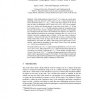Free Online Productivity Tools
i2Speak
i2Symbol
i2OCR
iTex2Img
iWeb2Print
iWeb2Shot
i2Type
iPdf2Split
iPdf2Merge
i2Bopomofo
i2Arabic
i2Style
i2Image
i2PDF
iLatex2Rtf
Sci2ools
91
Voted
ESA
2009
Springer
2009
Springer
Minimum Makespan Multi-vehicle Dial-a-Ride
Dial-a-Ride problems consist of a set V of n vertices in a metric space (denoting travel time between vertices) and a set of m objects represented as source-destination pairs {(si, ti)}m i=1, where each object requires to be moved from its source to destination vertex. In the multi-vehicle Dial-a-Ride problem, there are q vehicles each having capacity k and where each vehicle j ∈ [q] has its own depot-vertex rj ∈ V . A feasible schedule consists of a capacitated route for each vehicle (where vehicle j originates and ends at its depot rj) that together move all objects from their sources to destinations. The objective is to find a feasible schedule that minimizes the maximum completion time (i.e. makespan) of vehicles, where the completion time of vehicle j is the time when it returns to its depot rj at the end of its route. We consider the preemptive version of multivehicle Dial-a-Ride, where an object may be left at intermediate vertices and transported by more than one vehicle, ...
| Added | 26 May 2010 |
| Updated | 26 May 2010 |
| Type | Conference |
| Year | 2009 |
| Where | ESA |
| Authors | Inge Li Gørtz, Viswanath Nagarajan, R. Ravi |
Comments (0)

